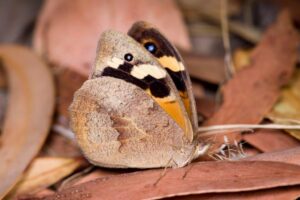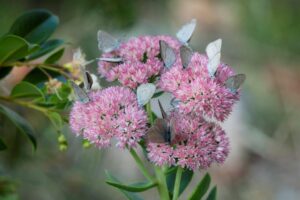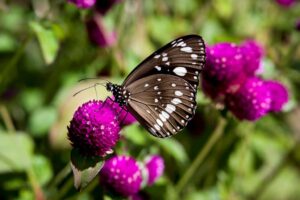Where have all the butterflies gone?
By Denis Crawford
Butterflies are desirable in gardens because they are indicators of a healthy environment. Unfortunately, they are under threat from climate change.
People enjoy seeing butterflies fluttering around their gardens and in bushland. Butterflies are considered to be harmless, perhaps with the exception of the cabbage white butterfly (Pieris rapae), and they are often quite large, colourful, and aesthetically pleasing.
Butterflies and their nocturnal cousins, the moths, make up the insect order Lepidoptera. The word Lepidoptera means ‘scaly winged’ from lepido (scale) and ptera (wing), which refers to the tiny dusty scales covering the wings and bodies of moths and butterflies.

About 180,000 species have been described so far, with the estimated total number to be around 300,000 species. The vast majority of lepidopteran species are moths rather than butterflies. For example, in Australia there are about 25,000 species of moths and only 420 species of butterflies.
Lepidopteran insects have been around for a long time. Fossil evidence suggests that the first moths appeared around 300 million years ago and had chewing mouthparts. The classic tube-like proboscis we know today didn’t appear until about 240 million years ago. At that time lepidopteran species were all moths. The first butterflies didn’t appear until about 100 million years ago and took advantage of the increasing diversity of day-flowering plants.
Butterflies are attracted into gardens by flowering plants to feed on, and larval host plants to lay their eggs on. Butterflies are pollinators. As they feed on nectar from plants, grains of pollen stick to the scales of their bodies and wings. They transfer some of those pollen grains to other flowers as they feed.
Butterflies are food for other animals, especially spiders and birds, therefore a garden that attracts butterflies is likely to attract other wildlife. Butterflies (and moths) and their larvae also attract and support a range of predators and parasites, which are essential in gardens as biological control agents.
Butterflies have been widely used by ecologists as model organisms to study the impact of habitat loss and fragmentation, and climate change. Butterflies are probably the most studied insects of all, and it was their beauty, size and collectability that drove early entomological research.

While researching for this Pest Files I came across some interesting recent research about butterflies threatened by climate change. Mountain species particularly suffer under climate warming and often respond to environmental changes by moving higher (Rodder et al. 2021). The abstract of the paper says, “Climate change impacts biodiversity and is driving range shifts of species and populations across the globe”. Where do the butterflies go once they reach the summit, I wonder?
Another study (Ashe-Jepson, E. et al. 2023) showed that the family, wing length and wing colour of tropical butterflies all influence their ability to withstand rising temperatures. Tropical butterflies with smaller or lighter coloured wings are more likely to be negatively affected by climate change. Tropical butterflies of the family Lycaenidae were found to be particularly vulnerable. Lycaenid butterflies are commonly referred to as ‘blues’ – and many of the tropical species are stunners. A species you may be more familiar with is the common grass-blue (Zizina labradus), the most widely distributed butterfly in Australia.
“Ultimately all insects, including butterflies, the world over are likely to be affected by climate change,” said lead author Esme Ashe-Jepson from the University of Cambridge. “Adaptation to climate change is complex and can be impacted by other factors such as habitat destruction. We need to address these two global challenges together.”
Closer to home, there is a well-known butterfly of southern Australia which according to research (Kearney, et al. 2010) has been affected by climate change. Common brown butterflies (Heteronympha merope) are emerging in spring over 10 days earlier than they did 65 years ago, and the study has linked this shift to human-induced climate change.

The life cycle of the common brown butterfly is an unusual one. Adult butterflies begin emerging in mid-spring, usually males first and then a week or two later, the females. The females mate almost immediately, usually only once, and then seek shelter to aestivate for the summer. The males continue to flutter about looking for females, but by mid-summer they have all died off. Females emerge from hiding in autumn, usually after some rain and grass growth, to lay their eggs.
If females are emerging earlier because of climate change that means they have to aestivate longer. Is there a limit to how long they can aestivate? I could find no data on that.
In some parts of its range this once abundant butterfly is in decline. Urbanisation and habitat loss is most likely to blame. The natural habitat of this butterfly is grassy woodland and dry eucalypt open-forest with a grassy understory. Larvae feed on grasses, mostly native but they have adapted to feed on some weedy introduced grasses.
I have often said that, in these situations, horticulture can be part of the solution rather than part of the problem. The planting of native grasses (Cynodon dactylon, Microlaena stipoides, Poa poiformis, P. tenera, and Themeda triandra) will go a long way towards keeping common brown butterfly populations healthy in urban areas.
Butterflies and moths are indicators of a healthy environment and healthy ecosystems. The solution is to keep them happy with flowering plants to feed on, and growing plants suitable for their larvae. Needless to say, minimising the use of pesticides and other chemicals will also help.
Here are some online places to visit if you want to learn what plants to grow for butterflies and their larvae in your area:
Australian Butterfly Conservation on Facebook
Moths and Butterflies Australasia (maba.org.au)
Butterfly Conservation South Australia Inc. (butterflyconservationsa.net.au)
References:
Ashe-Jepson, E. et al. (2023) Tropical butterflies use thermal buffering and thermal tolerance as alternative strategies to cope with temperature increase. J. Anim. Ecol. 92(9).
Kearney, et al. (2010) Early emergence in a butterfly causally linked to anthropogenic warming. Biology Letters, 6.
Rodder, D. et al. (2021) Climate change drives mountain butterflies towards the summits. Sci Rep. 11(1).

